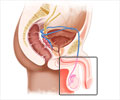Highlights:
- People infected with malaria exhale a distinct “breathprint” that was used by a research team to develop a diagnostic test for malaria.
- The test identifies a set of 6 compounds in the human breath that can serve to identify malaria.
- The study also found that terpenes released by infected humans are similar to a plant-produced molecule that attracts mosquitoes, carriers of malarial parasites.
The “breathprint”
For the first time the study was able to identify a set of compounds in the human breath that could serve as markers to diagnose malarial infection. This study is also the first to discover that infected people have a distinct breath, they call the “breathprint.” Just like the DNA blueprint inside of us gives information on the genetic level, the breathprint gives information on whether the person is affected with malaria or not.Study Overview
The research team identified malaria as the target for breath-based analysis as previous studies showed that the malarial parasites were capable of altering compounds that humans exhale. 35 children from Africa aged 3 to 15 were recruited out of whom 17 were previously tested positive for malaria and 18 tested negative. The objective of the study was to check if the breath test they developed could correctly identify the infection status of these previously tested children.The children were asked to blow into a balloon like bag that contained an absorbent material to trap the vapor. This was further sent into the laboratory in Washington University in St. Louis for analysis. Here it was discovered that malarial infections altered concentrations of 6 different compounds that naturally occur in human breath. The concentration measure was used to distinguish infected and uninfected breath samples. The test was accurately able to determine the malarial infection status in 83% of the children that gave the samples.
"We were able to determine whether the children were infected or not based on the composition of six different compounds that were detectable in a sample of their breath," said Chad Schaber, who presented the results of the study, produced by a team of biologists and bioengineers from Washington University in St. Louis. "We took breath samples from 35 children and we correctly determined the malaria status--whether they had malaria or not--for 29 of them, which is an 83 percent success rate."
Problem with current diagnostics for malaria
While there are several diagnostic tests for malaria including the rapid diagnostic tests (RDTs) which are finger prick tests, these continue to provide positive results even when the infection has subsided. Moreover, the deadliest malarial parasite, Plasmodium falciparum, does not produce the protein that most of these tests rely on, making the malarial parasite undetectable.Future prospects for breath-based malaria detection
The research team hopes to improve the diagnostic method by combining it with the latest technology. They hope to develop electronic noses or eNose which are pocket size devices that can be designed to detect specific smells. There is already a prototype eNose that is under development to diagnose tuberculosis with a breath sample.Spread of malaria through smell
When the breath samples of children were analyzed, the research team discovered two types of compounds called terpenes. One of these terpene compounds was identified to be the same as the one produced by certain plants to attract mosquitoes to feed on nectar."The terpene is probably a survival mechanism for the parasite, but this compound also might be useful in boosting the effectiveness of mosquito traps used in malaria control efforts," said Audrey Odom John, principal author of the study and associate professor of Pediatrics and of Molecular Microbiology at Washington University School of Medicine.
The research team believes that the malarial parasite is “hijacking” the mosquito’s in built attraction to odor. This encourages mosquitoes to bite infected people who release mosquito attracting compounds in their breath.
"The malaria parasite has been outwitting human interventions for thousands of years, which is why we need these innovative collaborations between biologists and engineers to develop new tools that can give us the upper hand," said Patricia F. Walker, MD, DTM&H, FASTMH, and President of the American Society of Tropical Medicine and Hygiene. "It sounds almost like something from science-fiction, but the ability to detect disease with a breath test may be closer than we ever could have imagined or hoped for."
Source-Medindia













